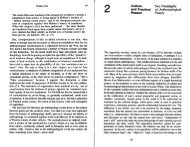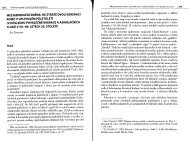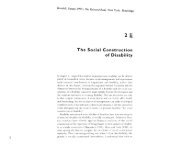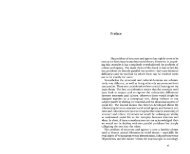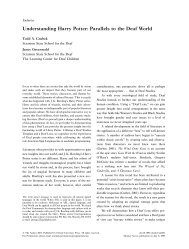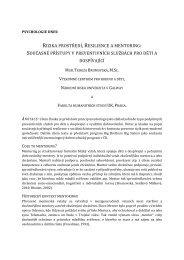Morphogenesis versus Structuration: On Combining ... - Moodle
Morphogenesis versus Structuration: On Combining ... - Moodle
Morphogenesis versus Structuration: On Combining ... - Moodle
You also want an ePaper? Increase the reach of your titles
YUMPU automatically turns print PDFs into web optimized ePapers that Google loves.
<strong>Morphogenesis</strong> <strong>versus</strong> structuration 465<br />
Does Giddens's formulation fare any better if we look at it the<br />
other way round, i.e. not focusing on what curtails freedom (tradition<br />
and routinization), but on the conditions under which higher degrees<br />
of freedom prevail Unfortunately this is not the case, the reason<br />
being that the 'transformative capacity' of actors is immediately<br />
conflated with the concept of power. <strong>On</strong> the contrary I would<br />
maintain that degrees of freedom are logically independent of the<br />
power of agents, the relationship between them being one of contingency.<br />
Systemic patterning determines a given potential for transformation,<br />
but:<br />
(a) this may not be capitalized upon by those with the power to<br />
do so;<br />
(b) its exploitation does not necessarily involve power;<br />
(c) considerable power can be deployed in this context without<br />
producing any transformation.<br />
The example of our decentralized educational system should clarify<br />
points (a) and (b), for this provides considerable structural degrees<br />
of freedom for innovation and change. Sometimes these remain<br />
unexploited, not because teachers lack the power to innovate but<br />
because they do not want transformation: sometimes they are used<br />
for the internal initiation of change without any application of<br />
power. Always to Giddens 'transformative capacity is harnessed to<br />
actors' attempts to get others to comply with their wants'.37This was<br />
not the case with the foundation of experimental schools nor with<br />
the move to progressive schooling, which involved a cumulative<br />
change in educational philosophy38 which could only be termed<br />
compliance by rendering that term vacuous (i.e. to accept anything is<br />
to comply with it). To clinch point (c), degrees of freedom may be<br />
large, but powerful contestants can lock in immobilism, as in cases of<br />
political 'centrism', like Fourth Republic France. In other words<br />
there are even some circumstances under which the use of power and<br />
the achievement of transformation are antithetic.39<br />
<strong>On</strong>ce again the contrast between the structuration approach<br />
and the morphogenetic perspective becomes pointed. In the latter<br />
structural elaboration can arise from three sources of interaction<br />
(besides their unintended consequences): the confluence of desires,<br />
power induced compliance or reciprocal exchange. Therefore in any<br />
given case the relationship between power and morphogenesis remains<br />
to be determined. <strong>Structuration</strong>, on the other hand, makes transformation<br />
logically dependent on power relations alone.40<br />
Whilst structuration attempts to transcend the voluntarism/determinism<br />
divide by a single conceptual leap (the 'duality of structure'),<br />
morphogenesis tackles the respective weightings of the two aspects<br />
by analysing the stringency of constraints and degrees of freedom in<br />
different structural contexts and for different social groups. The<br />
hare and the tortoise analogy is equally pertinent to the way these<br />
perspectives approach the next 'dualism'.



